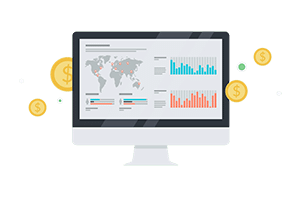Conversion Optmization
Conversion is about relevance: if you meet the needs of your potential customers then the page converts. We optimize your website or webshop to get your visitors to do what you want them to do, a continuous process usually called conversion optimization or (warning for marketing terms) CRO, Conversion Rate Optimization.
Why spending money on tweaking my website when I can spend it on advertising to get more traffic?
Let’s take a simple example of conversion optimization can impact your business and how incredibly important it is: by increasing your conversion rate from 1% of the visitors converting to 2%, your sales increase by 100%. By taking better care of the existing traffic on your site, you can thus greatly increase your sales without increasing traffic. Interesting, isn’t it?
Common issues we tackle in our CRO process
- How can we get more visitors to contact us or send quotation requests?
- How can we reduce the cart abandonment rate?
- Why do you have so many dropouts in the registration process?
- Why is your bounce rate over 50%?
- How can we get more visitors to see product pages?
Basically, any website acts as a conversion funnel where multiple steps are often required before a purchase or leads acquisition. Every funnel leak at each step with visitors dropping off, and our mission is to plug the wholes.
How Conversion Optimization works?
Conversion optimization is about getting into the details after you have fixed the obvious flaws on your website. There is often a lot of confusion about what it really is, with all the marketers self-proclaimed UX/UI/CRO expert. To clarify the method:
- Conversion Optimization is NOT:
- About making a website look “better”
- About gut feelings on what users like or not
- About best practices that anyone should apply
- Conversion Optimization IS instead
- A statistical approach based on data analysis and on the users behavior
- A systematic methodology testing improvements separately to clearly identify the impact of each change and learn from it
- Based on an advanced set of tools that require professional knowledge
Our methodology
Phase 1: Initial heuristic evaluation
This phase is a mix of testing the website by ourselves, and diving into the available data (starting with Google Analytics) to understand what doesn’t work on your website.
We generally unveil a lot of quick fixes to make at this stage, which don’t require testing or further analysis. But the main purpose is to formulate a number of hypothesis on what could make your website work better beyond the obvious.
Phase 2: Get the quick fixes done
We always start with the low hanging fruits to prove we can make a significant difference at the bottom line. There is no such thing as a perfectly functional website (or at least we haven’t see any yet)!
Phase 3: Testing plan
From our hypothesis, we use a PIE framework to sort them out:
- Priority – How urgent is the change
- Importance – What impact can we expect
- Ease – How difficult is it to fix, depending on the available resource
This allows us to build an initial test plan, making sure each test is set on a period of time allowing us to reach statistical significance with enough users.
Phase 4: Testing starting
Our preferred way of testing our changes is A/B testing, sending 50% of the visitors on the original page and 50% on our alternative page that we’ve improved to measure the impact.
The number and duration of test vary greatly from a project to another.
Phase 5: Leverage on the learnings
The initial tests bring a great deal of fresh data that can be used in other areas of the website and tell us more about your audience.
However, in most cases we will need to diversify the sources of data to understand what’s wrong with a low performing page. Here are a few examples of further investigations we usually conduct:
- Users session recording, heatmapping
- Qualitative interviews / test session with a small group of test users
- Quantitative interviews / online surveys
Phase 6: Rinse and repeat
From all these learnings we build new hypothesis, and we start all over from phase 3.
Main requirements for a successful CRO campaign
- Clearly define your objectives, and what you’d like to get from the visitors in priority
- Make sure your website tracking is flawless, with the right setup, events, goals and custom reports. We very often start our CRO project by a quick tracking tools audit, as it’s never as simple as it sounds.
- Define your technical implementation capabilities, to make sure we make suggestions that can be realistically implemented in a reasonable delay

